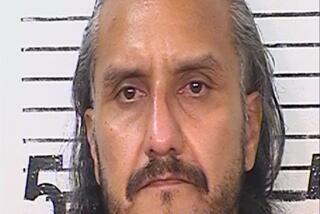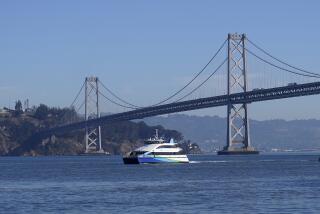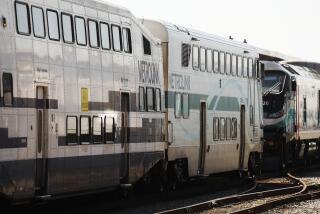Accident Site Popular for Hopping Trains : Tragedy: Injured man is one of thousands of train-riding workers who have hitched rides at Capistrano Beach curve in Dana Point.
DANA POINT — Ken Cassady was spraying a clump of weeds outside his Doheny Park Road nursery Thursday morning when an ear-piercing scream almost curdled his blood.
“It was the most god-awful scream,” Cassady recounted Friday morning.
But it wasn’t until he heard one distraught man screaming “Mi hermano, mi hermano, “ (My brother, my brother) that he noticed the bloodied body of Juan Carlos Martinez lying across the tracks, his legs crushed.
“I was paralyzed,” Cassady said.
But he was not surprised.
Over the years, the sharp curve directly behind Cassady Bros. Nursery has become a train depot of sorts for the thousands of undocumented workers who hitch a ride on the freight trains. On a given day, as many as 300 train-riding workers pass through the Capistrano Beach business district, several businessmen in the area estimated.
The daily train hopping has been an accident waiting to happen, officials said.
The Capistrano Beach curve behind the business district is a popular spot for undocumented workers because trains slow to about 10 m.p.h., allowing the riders to hop on and off with relative ease.
At 8 a.m. on Thursday, Martinez, 18, apparently slipped and fell under a train that was returning to San Diego from Barstow, law enforcement and train officials said. He was taken to Mission Hospital Regional Medical Center, where his legs were amputated during a seven-hour surgery.
Martinez was listed in serious but stable condition on Friday, hospital spokeswoman Nancy Gasho said.
Martinez was traveling with his 20-year-old unidentified brother, officials said. Both men declined interviews.
Sante Fe spokesman Bob Gehrt said the accident, while the first in the Capistrano Beach area in years, is not uncommon nationwide.
In 1988, the last time figures were compiled, 570 people were killed and 836 were injured nationwide as a result of trespassing on train tracks or attempting to jump on a moving train, Gehrt said.
“It’s a terrible problem,” Gehrt said. “We try like the dickens to stop trespassing. It is very dangerous.”
The railroad company has arrested 3,816 people for trespassing between San Diego and Fullerton stations, Gehrt said. All but three of them were determined to be illegal aliens looking for work, he said.
“I don’t know what you can do to stop it,” said nursery owner Cassady, who helped splint Martinez’s legs with small pieces of wood and twine until paramedics arrived.
“It’s not going to get better, it’s going to get worse as long as there are jobs here,” he said. “I have a lot of respect for these people. All they want to do is work.”
The incident shook up the Latino immigrants who waited for trains on Friday.
Felipe Cota stared at the tracks as he tossed pebbles onto the ground near the rails.
“I know a friend who was hurt here,” said the 19-year-old from Guadalajara, Mexico. “He lost his balance when he jumped and landed hard. He broke his arm and didn’t know where to fix it, so now it looks funny.”
Using the railroad instead of a coyote--a person paid to take illegals across the U.S.-Mexico border--saved Cota about $1,000, he estimated.
Instead of paying someone to take him past the Border Patrol checkpoint near San Clemente, Cota said he was able to pick up the train near the San Diego freight yards with four other men and ride in comparative style in a boxcar.
Trudging along the train tracks near the San Juan Creek, Mario Corral, 27, of Mexico City, said he was afraid the first time he hopped on a train bound for what he hoped was a better life in the United States.
“All I could see before I jumped off the train was the ground rushing past me, and I thought, ‘Oh, my God, what if I fall under the train,”’ Corral said.
“So I jumped as far as I could, and I scraped my knees and chin on the rocks,” he continued. “But I was not hurt badly.”
The need to send money home outweighed his fear of hitching a ride on a Santa Fe freighter in San Diego.
“It is the best way to go into California,” he said. “It is better than riding in the trunk of a car and hoping you are not caught by la migra (immigration officers).”
More to Read
Sign up for Essential California
The most important California stories and recommendations in your inbox every morning.
You may occasionally receive promotional content from the Los Angeles Times.










